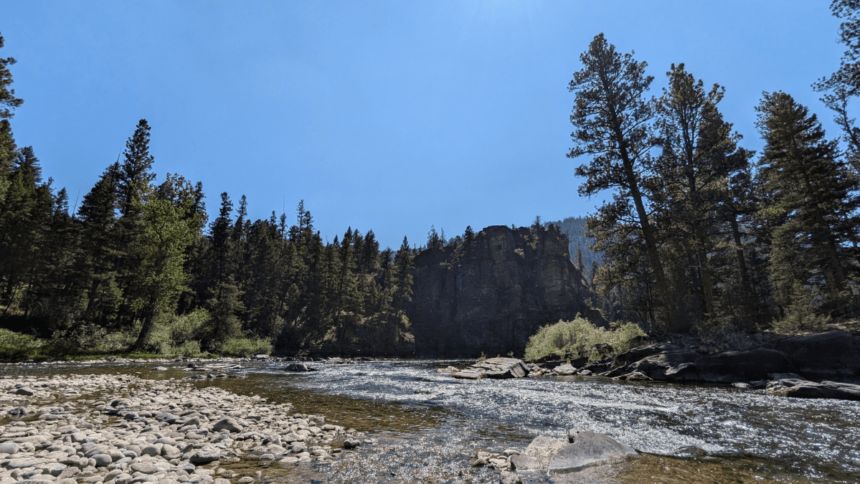Montana Fish, Wildlife and Parks is asserting the water rights it holds in 10 Montana rivers to keep more water in cold-water fisheries facing low flows wrought by this winter’s meager snowpack.
FWP water rights and instream flow specialist Stephen Begley told Montana Free Press that the department has used its fishery- and recreation-oriented water rights to bolster flows in the Blackfoot, Missouri, Jefferson, Boulder, Beaverhead, Smith, Shields, Tobacco, and Gallatin rivers. The agency also this week decided to enforce a water right it holds for a Kootenai River tributary — Young Creek — and is evaluating whether a similar call is merited on Rock Creek, a popular trout fishery that flows into the Clark Fork River.
Most of the water rights FWP holds to protect popular Montana fisheries are dubbed “Murphy Rights.” They are named after the state lawmaker who sponsored a bill in 1969 seeking to protect the water supply critical to fish in a dozen of the state’s blue-ribbon rivers.
Murphy Rights, along with a collection of other FWP-held water rights, allow the state to “make a call” on junior water users. In practice, that means the department will send letters to users with newer rights directing them to cease withdrawals from a given stream or river. The system was developed to work within Montana’s water rights ownership framework, which holds that individuals or companies with the oldest water rights are given priority during periods of low water.
“A year like this, we have [hoot owl] restrictions, we have closures and we have really low flows,” Begley said. “This season has been a real challenge.”
Begley, who’s worked at FWP for 12 years, said multiple considerations go into play when the agency decides whether to ask junior right holders to stop using water, ranging from the weather outlook to the existence of local drought management groups.
Region 2 Fisheries Manager Patrick Saffel was involved in the decision to exercise the Murphy Right that FWP holds for the Blackfoot River, which has seen near-record low flows this year.
“The Blackfoot tends to be one of the more resilient drainages, and this year it was our worst,” he said. “We often rely on a lot of that high-elevation snow that’s going to last longer in the summer on the north side of the drainage, and this year we just didn’t get it.”

Saffel added that he’s generally seen a trend toward earlier runoff, meaning there is less water to sustain rivers in the summer. That points to continued challenges, he said, even during years when the snowpack far exceeds this year’s.
“It’s like there’s another month of summer, with less water,” he said. “A normal snowpack is not enough if it runs off early.”
Krista Lee Evans, who until recently represented irrigators’ interests in the Comprehensive Water Review Working Group convened by the Montana Department of Natural Resources and Conservation, said difficult summers like this one demonstrate the importance of “shared shortage” efforts that aim to spread some of the pain associated with meager water supply in overallocated basins.
Evans said the Blackfoot Challenge and the Association of Gallatin Agricultural Irrigators can alleviate shortages in basins where the amount of water that’s already been promised to users far exceeds the supply.
“In the Gallatin, they work collaboratively. That basin is so over-appropriated that if everyone exercised their water right to the fullest extent they could, we would dry up the river five times over,” Evans said. “It’s nothing in writing, it’s just what they do to keep the river wet because they value the river just like trout people or tourists or anybody else.”
Evans said there are policy considerations that have a bearing on water availability, too.
“In closed basins, in over-appropriated sources, we need to think seriously about the use of wells that are exempt from the permitting process and the impacts of those withdrawals, especially during times of shortage,” Evans said, referencing a Montana law that under certain conditions allows individuals and businesses to drill wells without acquiring a water right or analyzing the well’s impact on other users.
Casey Hackathorn, the Montana director for Trout Unlimited, echoed Evans’ concern about exempt wells. He said there is no “silver bullet” to fix our complicated water management system and emphasized the importance of maintaining water levels to support fish habitat.
“We’ve been trying to nudge the system in a direction that recognizes that need while trying to take care of people and fish at the same time — trying not to throw the baby out with the bath water,” he said. “We have a system, and we’re basically trying to work with that and be creative and find ways to adapt.”
Hackathorn lauded efforts to “build resilience in the system,” such as restoring wet meadows and installing structures that mimic beaver dams, both of which can increase a basin’s storage.
“With changing climate patterns that result in earlier runoff and lower streamflows, holding back water is definitely something that [Trout Unlimited] and a lot of our partners are working on,” Hackathorn said. “I think a lot of chickens are coming home to roost now that have been predicted over a long period of time. It’s something we need to be prepared for.”





